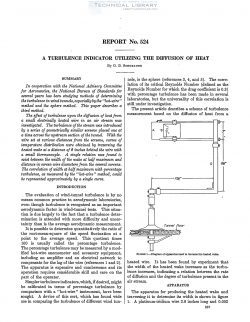naca-report-524

- Version
- 156 Downloads
- 411.23 KB File Size
- 1 File Count
- August 30, 2016 Create Date
- August 30, 2016 Last Updated
National Advisory Committee for Aeronautics, Report - A Turbulence Indicator Utilizing the Diffusion of Heat

In cooperation with the National Advisory Committee
for Aeronautics, the National Bureau of Standards for
several years has been studying methods of determining
the turbulence in wind tunnels, especially by the “hot-wire ”
method and the sphere method. This paper describes a
third method.
The efi’ect of turbulence upon the difi‘usion of heat from
a small electrically heated wire in an air stream was
investigated. The turbulence of the stream was introduced
by a series of geometrically similar screens placed one at
a time across the upstream section of the tunnel. With the
wire set at various distances from the screens, curves of
temperature distribution were obtained by traversing the
heated wake at a distance of 2 inches behind the wire with
a small thermocouple. A single relation was found to
exist between the width of the wake at half mamimum and
distance in screen wire diameters from the several screens.
The correlation of width at half maximum with percentage
turbulence, as measured by the “hot-wire” method, could
be represented approrimately by a single curve.
The evaluation of wind-tunnel turbulence is by no
means common practice in aerodynamic laboratories,
even though turbulence is recognized as an important
aerodynamic factor in wind-tunnel tests. This situa-
tion is due largely to the fact that a turbulence deter-
mination is attended with more difiiculty and uncer—
tainty than is the average aerodynamic measurement.
It is possible to determine quantitatively the ratio of
the root-mean-square of the speed fluctuation at a
point to the average speed. This quotient times
100 is usually called the percentage turbulence.
The percentage turbulence may be measured by a mod-
ified hot-wire anemometer and accessory equipment,
including an amplifier. and an electrical network to
compensate for the lag of the wire (references 1 and 2).
The apparatus is expensive and cumbersome and its
operation requires considerable skill and care on the
part of the operator.
| File | Action |
|---|---|
| naca-report-524 A Turbulence Indicator Utilizing the Diffusion of Heat.pdf | Download |

Comment On This Post